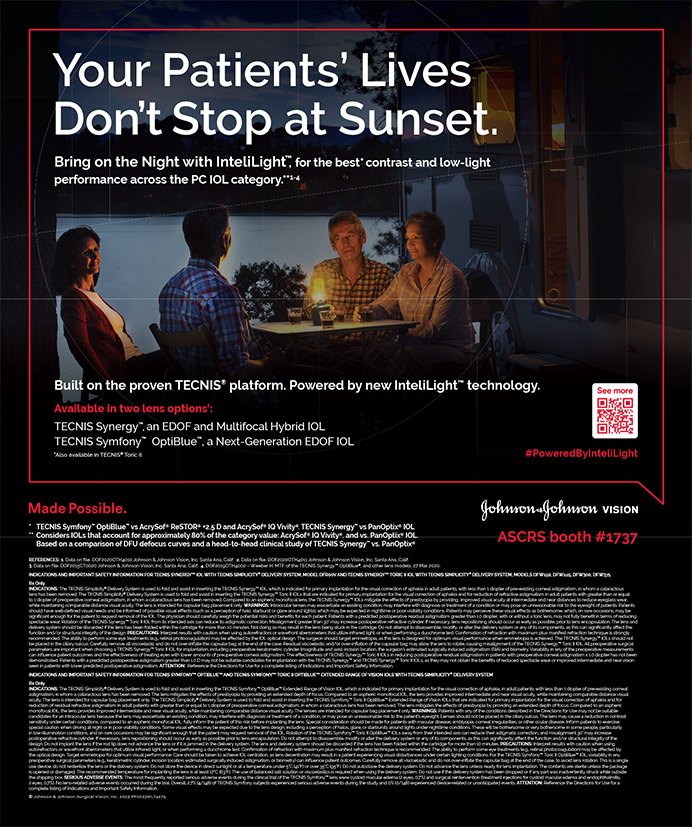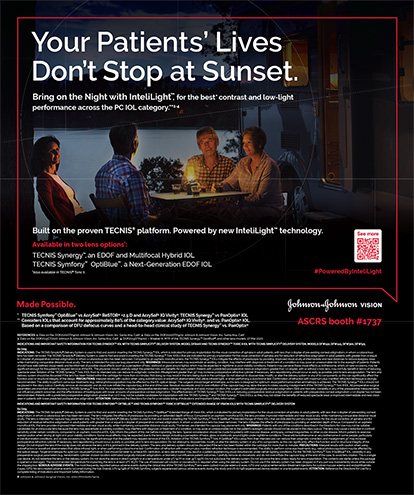During the last week in February, I had the privilege of being the first ophthalmic surgeon in the United States to perform cataract surgery using a femtosecond laser. The procedures that my team and I performed over a 2-day period with the LenSx Laser (LenSx Lasers, Inc., Aliso Viejo, CA) are the beginning of what I believe will be the next evolution in refractive cataract surgery.
The LenSx Laser received FDA clearance for anterior capsulotomies in August 2009 followed by clearance for corneal incisions in December 2009. I used the LenSx Laser to create anterior capsulotomies and corneal incisions for the cataract procedure. In the future, it is hoped that the FDA will allow the use of the LenSx Laser for the splitting, chopping, and softening the nucleus.
PROCEDURE AND PATIENTS’ ACCEPTANCE
I performed these first surgeries at my ambulatory surgery center in Houston with the second laser the company has manufactured (the first unit is in Europe). The surgical outcomes were even better than I had expected. I have performed eight cases, and all patients saw 20/25 or better on postoperative day 1. All of the capsulotomies that I attempted were perfectly centered and achieved a diametric accuracy of ±0.25 mm. The laser effectively created precise corneal incisions, and all were self-sealing postoperatively. After cataract removal using phacoemulsification, all of the eyes received a premium IOL. Anecdotally, both my partner and I independently felt that the corneas on day 1 were exceptionally clear, perhaps due to less intraocular maneuvering and manipulation of the corneal tissue.
I believe that patients will benefit from a lower complication rate associated with the femotsecond laser technology and from what I anticipate will be improved refractive results. The ability of the laser to make reproducible corneal incisions and capsulotomies will allow surgeons to optimize the lens’ position, more effectively manage preexisting astigmatism, and reduce induced astigmatism. In fact, in the future, ophthalmologists will be able to make corneal astigmatic incisions to deal with preexisiting or induced cylinder with the laser.
As impressive as the performance of the LenSx Laser was, the overwhelmingly positive response from the patients was even more exciting. Then again, patients have always thought that cataract surgery was performed using a laser, which may have helped overcome any concerns they had about being the first US patients to undergo surgery with this new technology. I believe femtosecond refractive cataract surgery will become the preferred method for performing this surgery. Patients are extremely excited about laser cataract surgery, and surgeons will find the procedure more precise and reproducible as well as simply more fun.
HISTORICAL PERSPECTIVE
The initial clinical evaluation of the LenSx Laser began in 2008 with Zoltan Nagy, MD, of Semmelweis University in Budapest, Hungary.1,-3 He has now successfully performed over 500 surgeries with the LenSx Laser, including the first image-guided refractive cataract surgeries with the laser in December 2009. This surgery involved lens fragmentation, the capsulotomy, and corneal incisions.
My initial experience of performing the capsulotomy and corneal incisions has been extremely positive. In my years as a refractive and cataract surgeon, I have had the good fortune to be involved in the introduction of a number of new procedures, including the first customized ablation for LASIK and the femtosecond laser for the creation of corneal flaps. Without a doubt, my first surgeries with the LenSx Laser were as smooth and routine as I could have hoped.
In the past 15 years, several companies have attempted to deliver a laser for cataract surgery. With the LenSx Laser, I believe that surgeons will soon have a cataract technology that allows their technique to match the advanced nature of premium IOLs. The result will be improved outcomes.
Stephen G. Slade, MD, is a surgeon at Slade and Baker Vision in Houston. He serves as the medical director for LenSx Lasers, Inc. Dr. Slade may be reached at (713) 626-5544; sgs@visiontexas.com.
- Nagy Z.Application of an integrated OCT in novel femtosecond laser cataract surgery.Paper presented at: The 14th Winter ESCRS Meeting; February 14, 2010, Budapest,Hungary.
- Nagy Z.Use of femtosecond laser system in cataract surgery.Paper presented at:XXVII Congress of the ESCRS; September 15, 2009;Barcelona, Spain.
- Nagy Z.Intraocular femtosecond laser applications in cataract surgery.Cataract & Refractive Surgery Today Europe.2009;4(8):29-30.


